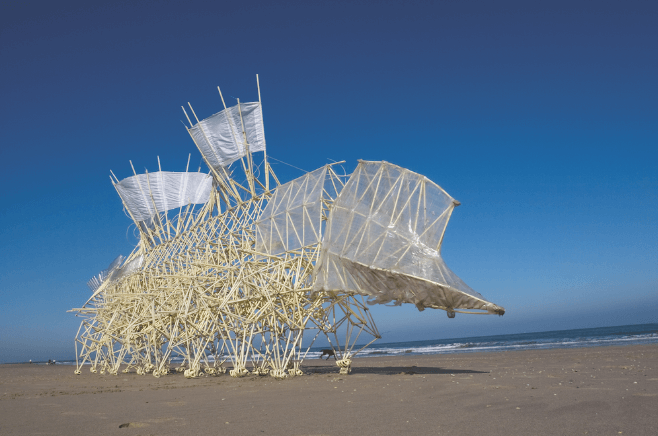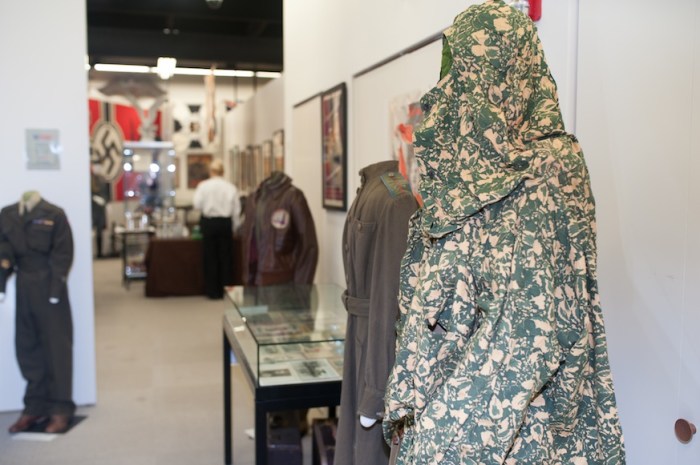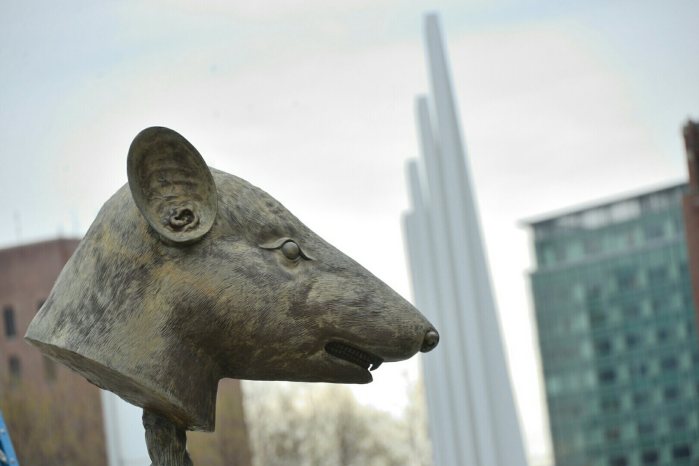The creatures are tall and ungainly looking, with a geometric skeletal structure and an uncanny gait. It’s hard to look away once they get moving, but that’s just the magic of the Strandbeests, the evolving wind-powered structures built out of plastic tubing that Dutch artist Theo Jansen has been building over the last two decades. It’s been a meticulous process of trial and error over the years, as Jansen has tried to find the right design to make them self-sufficient. The first American tour of the Strandbeests has just begun at the Peabody Essex Museum, and we talked to Jansen about his life’s work. How did you first get started working on this project?
It was in 1990. I was a writer in those days and I wrote a column in the newspaper about the idea of some skeletons which would catch the wind from the beach and they would build dunes by themselves and they would protect the country from the rise of the sea level. After publication, nothing happened. And then I passed a tool shop and I bought some of these tubes, because these tubes are used in Holland for electric conduit, for cables and houses. And I played for an afternoon with those tubes and then the next afternoon I’d seen so many things that I decided to spend one year on the tubes, and things got totally out of hand, because that was 25 years ago. RELATED: The Who are coming to town, and other great fall music events in Boston Why do you use only those tubes to create them?
The first reason to use this material is because it’s cheap. But going on with it, I noticed that I get attached to the material and I notice that I could use it as a building system. Since then I tried to restrict myself just to this kind of tube, but philosophically, you could also say that the real creator, he just used protein to make us and so you could say that the real creator restricted himself or herself with the choice of his material…. At first thought is that you restrict yourself and your possibilities as well but in fact it forces you to take routes, which are not very obvious so you are forced to create escapes from the normal path. So I am quite faithful to the tubes, and they help me to create the beasts. What defines the shape of the creatures, artistic impulse or functionality?
I don’t try to make it beautiful because I’ve tried it at the past, and I usually don’t succeed. It becomes beautiful if you just follow the instructions of the tubes and follow the instructions of functionality. People praise me for the beauty of the beast, but in fact I’m not really responsible for that. It became beautiful on its own. RELATED:Iliza Shlesinger, Joel McHale and all your fave comedians are coming to Boston Videos of the Strandbeests walking have been very popular on YouTube. What do you think it is that people find so mesmerizing?
Our eyes are quite sensitive for animals, because in evolution it could either mean something to eat or something to run away from. So if you see just a moving animal in the corner of your eye, then still you will recognize immediately the movement of an animal. In these structures, you see the movement of an animal, but it’s something mechanical. … Usually people start smiling when they look at it. I don’t know why. Did you know when you first started on it that you might be in it for the long haul?
I must say yes. I saw it. But I had many dreams in those days. I was playing in a band. I had a career in front of me as a rock star, which obviously didn’t succeed, but I had this dream that I would show my work all around the world, and it would take a long time. “Strandbeest: The dream machines of Theo Jansen” runs through Jan. 3 at the Peabody Essex Museum. Head to www.pem.org for details.
Theo Jansen and his Strandbeests come to Peabody Essex Museum

Courtesy of Theo Jansen. Photo by Loek van der Klis.


















